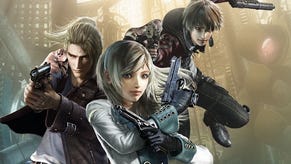Resonance of Fate
A towering achievement?
Despite its strengths, the hex system plays second fiddle to the game's most innovative and idiosyncratic feature: its battle system. Complex and with many rules and quirks, this has you controlling your three characters in sequence in a semi real-time tussle.
As with SEGA's Valkyria Chronicles, moving and attacking share an action point gauge. A character's turn ends when either the action gauge depletes or they attack. In the game there are two types of damage that the player can inflict on opponents: direct damage and scratch damage.
The type of damage inflicted is dictated by the type of weapon they have equipped, 'direct' from handguns and thrown weapons and 'scratch' from machineguns. Direct damage drains an enemy's health irrevocably, while scratch damage deals a greater amount of injury, but recovers with time and does not destroy the enemy when reduced to zero.
Much of the game balance comes from inflicting a large amount of scratch damage with one character, and then turning it into direct damage with another before it has chance to replenish.
Attacks can be dealt in one of two ways. Standard attacks simply require you to lock on to a specific target and charge up a standing attack. Hero Actions, by contrast, allow you to plot a course across the battlefield, before running along that line while repeatedly attacking enemies, only stopping if you collide with an obstacle or reach the edge of the play area.

Hero Actions use up what quickly reveals itself to be the most important resource on the game: Bezels. Initially you have three bezels with a Hero Action costing one bezel per use. Run out of bezels and your team is critically wounded, with hugely scaled-back abilities. In most cases, you won't recover from this state and it's game over.
Bezels are replenished every time you defeat an enemy or part of an enemy (an arm, leg or shield, for example). The strategy then comes in balancing those crucial Hero Actions with how close you are to defeating an enemy or enemy part.
Be too conservative in your use of Hero Actions and you won't take enemies down quick enough. But conversely, be overeager and you'll find you'll find yourself in a critical condition before time. Learning when to push forward and when to hold back takes time, but when you nail to balance, is extremely satisfying.
The system is granted a final tier of complexity by way of the Tri-Attack, a combination attack that can be triggered under certain conditions. Running between the other two characters during as Hero Action earns a Resonance point, which can then be spent on activating a Tri-Attack during your next character's turn. During this attack the three characters race along the sides of the triangle their positions form, each character blasting away at the targeting enemy and dealing dizzying amounts of damage.
The battle system has a steep learning curve and, while it's possible to bluff your way through encounters with standard grunts, as soon as you face a boss character with multiple armour segments you'll need a good handle on how everything works if you're to have any chance of success.

Yet more time is to be sunk into customising the game's weaponry, which, rather like piecing together guns in Resident Evil 4, has you attaching scopes, new barrels and all manner of add-ons and mods to create ever more fanciful weaponry.
Again, this is an ingenious upgrade to the rote-RPG system of purchasing new and better weapons to match the tougher enemies you face as you progress, increasing the sense of player agency and introducing just the right amount of non-linearity to your characters' progression.
At times you'll have no doubts that this is the best JRPG of the generation, a fast-paced, interesting and creative detour from a stagnant mainstream. At other moments, usually when facing the tenth Game Over screen during a difficult boss battle, you'll wonder whether the game suffers from poor balance, born from its developer's stubborn insistence on novelty for the sake of it.
Either way, by the end of the adventure you'll be certain that Resonance of Fate's approach is a one-time affair, unlikely to inspire any copycats. Its ideas are simply too leftfield, and too fully realised to be closely imitated.
Nevertheless, this is a hugely interesting game, as fascinating as it is frequently frustrating, as engaging as it is eccentric and, for those who are hooked by its quirky charms, it will provide one of the most inspired approaches to the JRPG seen in a decade.









